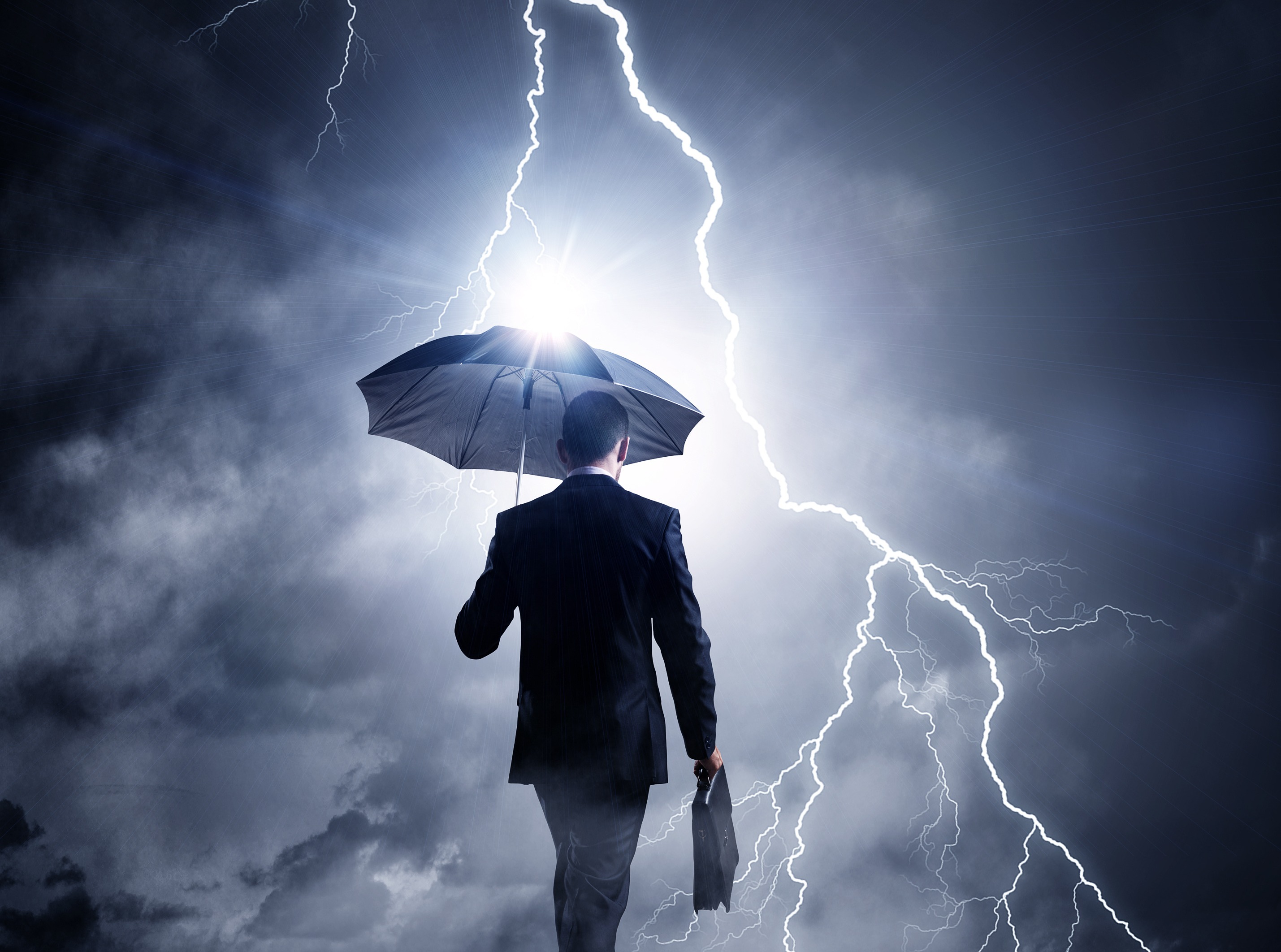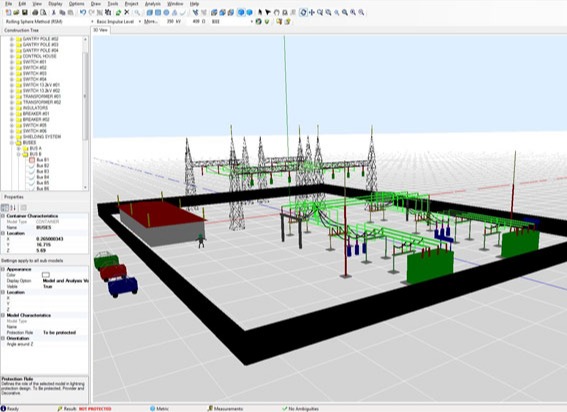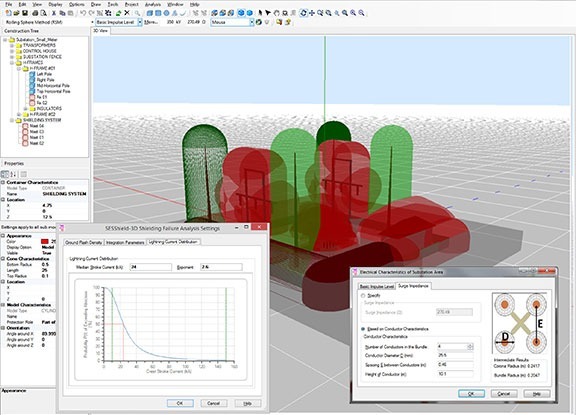Our Services
Lightning Risk Assessments

Overview
Some equipment facilities are more at risk from a lightning strike due to many factors such as the the region where the facility is located, the construction of the building and whether or not there are any existing lightning protection devices such as surge protectors and grounding electrodes installed.
If a building that is not protected is struck by lightning, the lightning can travel through the walls instantly turning any moisture into steam which may result in a high pressure explosions of concrete walls. Loss of service and injury to personnel are also a high risk factor.
Comprehensive Lightning Risk Assessments
E&S Grounding Solutions provides comprehensive lightning risk assessments and lightning protection plans that will help to ensure that a lightning strike will not cause catastrophic failures, injuries or fatalities at equipment facilities. Our lightning risk assessment and proposed lightning protection plans illustrate the current risks and necessary steps that should be taken in order to meet the guidelines as set out in NFPA 780 and IEEE 998.
NFPA 780 provides lightning protection system installation requirements to safeguard people and property from fire risk and related hazards associated with lightning exposure. While NFPA 780 has no force in law, it is generally recognized as the primary lightning protection document in the USA. The purpose of NFPA 780 is to safeguard persons and property from lightning.
NFPA 780 has two risk assessments, a simplified version and a detailed version. The simplified tells you if your site needs a lightning protection system, while the detailed tells you if a partial lightning protection system will work, or if you need a full system. We typically run both versions in order to determine where cost savings can be made.

Improved Lightning Flash Density Forecasts
Few areas are free from thunderstorms and the hazard of a lightning strike, but some areas have more storms than others. The higher the lightning flash density (or ground flash density), the higher the probability of a lightning strike at your facility which will require a higher level of lightning protection.
Determining the lightning flash density at a given facility location is of vital importance. IEEE 998 estimates lightning flash density based on average number of thunderstorm days or ‘keraunic’ level. NFPA 780 uses the default national flash density map with data from 1997 to 2010. Instead, E&S Grounding Solutions provides an improved a report containing up-to-date lighting flash data gathered from the National Oceanic and Atmospheric Association Severe Weather Data (NOAA) specifically for the precise plot of land where the facility is located. This allows for calculating much more accurate future predictions.
Assessing the Risk of a Lightning Strike
Performing a lightning risk assessment to determine if a facility needs a lightning protection system requires the engineer to evaluate environmental factors and tolerable risk factors. A calculation is then performed to determine if a lightning protection system with surge protection devices is required.
Our lightning strike risk assessments are calculated using several environmental factors including:
• Characteristics of buildings and equipment such as:
Building construction, equipment costs, ability to withstand voltage, flammable materials, cable and wiring layouts.
• Current lightning protection measures such as:
Surge protection, shielding, grounding electrodes or lightning rods
We also factor in the following risks:
• Risk associated with fire
• Risk associated with loss of life or injury
• Risk associated with loss of service
• Risk associated with loss of equipment
Based on an analysis of all of the above factors, a detailed lightning risk assessment and lightning protection plan is developed for the site facilities. The goal is to achieve an acceptable risk level with the proposed lightning protection system according to NFPA 780.
Our Lightning Risk Assessment Process
Our lightning strike risk assessment process typically follows these steps:
• NFPA 780 lightning risk assessment – This assessment uses a variety of environmental and engineering factors to determine two variables:
Does the site require a lightning protection system?
If so, what level of protection is required?
There are four lightning protection levels, I-IV, with I having the highest level of protection.
• IEEE 998 lightning strike shielding analysis:
This assessment analyzes the lightning protection system to be installed at the site and its capacity to handle lighting strikes along with other important data.
• The following steps are required to conduct a IEEE 998 lightning risk assessment:
Ground flash density.
Stroke current range.
Unprotected area of the site in square feet.
Expected number of failures due to lightning flashes per year (in the unprotected area of the site).
• Determine proper surge protection devices required for the site:
Determine voltage and current levels necessary given the lighting flash risk for the site with the proposed lightning protection system.
Determine where the surge protection devices must be installed on the site.
Lighting Protection System Design
A lightning risk assessment and a lightning protection system is an important component in protecting employees, equipment, electrical systems and critical business processes. E&S Grounding Solutions provides comprehensive lightning risk assessments and lightning protection plans which include a full report with findings and recommendations for implementing a lightning protection system that meets NFPA 780 requirements.
Our lightning risk assessment and lightning protection plan includes:
• A review of the existing lightning protection system against national standards (NFPA 780 and IEEE 998)
• An assessment of the risk of a lightning strike to people, buildings and equipment at the facility
• A calculation of risk and a determination of whether a lightning protection system is needed
• A description of the proposed lightning protection system including:
A list of the proposed system, surge protection devices and accessories.
The location of the systems to be installed.
Click here to learn more about:
Lightning Risk Assessments

Using the SESShield 3D program, complex environments can be modeled in three dimensions and then properly analyzed for its effectiveness.

Once the site has been properly modeled, the software can analyze the effectiveness of the proposed Lightning Protection System, both full systems and partial systems, and will provide critical data for completing the IEEE 998 and IEC Lighting Risk Assessment processes.
SESShield-3D
E&S Grounding Solutions utilizes the powerful SESShield 3D software package from Safe Engineering Services & technologies ltd, which is the same industry leading software used by both the NFPA and IEEE in developing their standards.
With the assistance of this powerful software package, the engineers at E&S Grounding Solutions can analyze and design lightning shielding protection systems for complex 3D environments, including substations, power plants, industrial plants and other such installations, accounting for the presence of power lines, equipment, buildings, etc.
Multiple shielding methodologies from IEEE and IEC standards can be analyzed, including:
• Rolling Sphere Method (also known as the Electrogeometric Model) and variations thereof
• Eriksson Electrogeometric Model, which takes into account the height of the structure
• Protection Angle Method
• Mesh Method
• Collection Volume Method
Mitigate the Risks of a Lightning Strike to Your Facility
Our lightning risk assessments are conducted by engineers who have no products to sell, just the technical expertise needed to help the electrical engineer design proper lightning protection systems and surge protection devices, and tie these back in to a properly designed electrical grounding system. From the top of a lightning aerial to the bottom tip of a ground rod, or from the center-tap of the transformer out to the final branch circuit, E&S Grounding Solutions can help you with all of your grounding, earthing, and bonding needs.
Contact us for more information on implementing a Lightning Risk Assessment and Lightning Protection System plan for your facility today.
Let's Talk! Schedule a Free Phone Consultation Today.
Schedule a FREE Discovery Call with David Stockin, Founder CEO and Managing Partner.
Wherever you are located, let's meet in a 15-minute call and see how we can assist with your project.
Do you prefer to reach us via email?
Ask the Grounding Experts.
